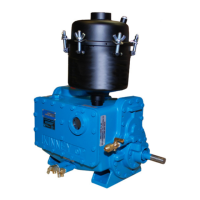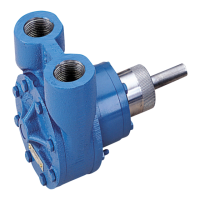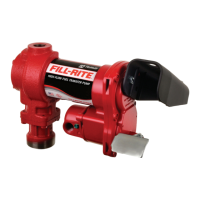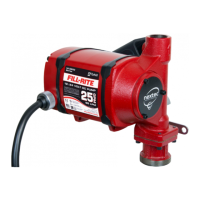Manual 1808 Rev B p/n 001808 0000
8
04
Description
Each rotary piston is composed of a cylindrical
element that encloses the shaft and a hollow
rectangular extension that moves through a slide
pin. The piston slide pin has openings that are
covered and uncovered as it passes through the
slide pin, allowing gas to enter the cylinder and be
compressed. The ends of the cylinder are enclosed
by an open head, through which the shaft extends,
and a closed head. The shaft has a mechanical
seal on the open head end to prevent leakage
around the shaft. Spring-loaded discharge valves
are located at the discharge side of the pistons. An
oil separator oil mist eliminator is mounted on top
of the pump and connected to the discharge of the
pump. A sight gauge in the oil separator is provided
for checking the oil level. When pumping at low
inlet pressure, the oil level should be in the center
of the sight gauge.
NTE: N The oil level will change with large
changes in pump inlet pressure.
OPERATING CYCLE
The operating cycle is shown in Figure 4-1 on
page 7. Gas from the system enters the pump
through the inlet, and from there it passes through
the hollow piston-slide and out the slide port into
the space being created between the piston and
cylinder wall. As the piston rotates, this space
increases and more gas is drawn in while at the
same time the gas taken in and trapped. The
previous revolution is on the compression side of
the piston and slide. Here, the gas is compressed
and forced out through the discharge valves along
with a small amount of oil and then into the oil
separator, where the oil is separated from the gas.
The gas is discharged to the atmosphere, and the
oil drains back into the reservoir. The KD pump has
a lter to remove visible fumes from the discharged
gas.
SEALING AND LUBRICATING
The oil ows through the pump by means of
differential pressure between atmosphere and the
pump inlet, and it is drawn into the pump at each
head through the shaft bearings. The cylinder
walls, pistons, and slide pin are lubricated and
sealed against the backow of gas by a lm of
oil that lls the close running clearances. The
cylindrical part of the piston almost touches the
pump cylinder at a line along the length of the
piston, and as the piston continues to rotate, oil
builds up ahead of this line and seals the space
between the piston and cylinder wall. The excess
oil is discharged with the gas and is returned to
the oil reservoir. At low pressures, the air becomes
mixed with the oil and the solution is discharged on
the compression stroke.
OIL TYPES
The ability of the KD-30 and KD-50 pumps to
obtain and hold pressures in the low micron range
depends on the use of the proper sealing and
lubricating oil. AX Vacuum Oil is recommended as
it has characteristics necessary to obtain a dry,
low vapor pressure uid with suitable viscosity.
Other applications such as oxygen pumping
may require changing oil to Fomblin® or other
peruoropolyether (PFPE) where low temperatures
are likely to be encountered. Other special uids
used are polyglycals, uorocarbons, and FDA-
approved lubricants. Consult the factory before
changing from the recommended oil to ensure that
the new uid and present seals are compatible.
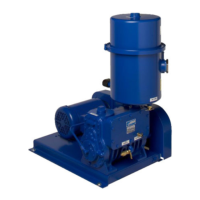
